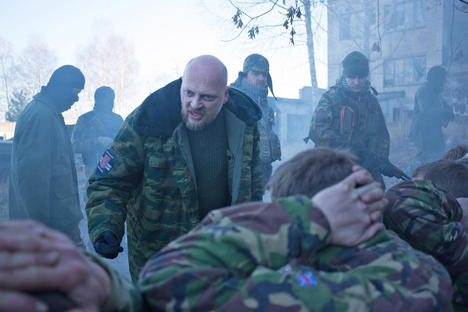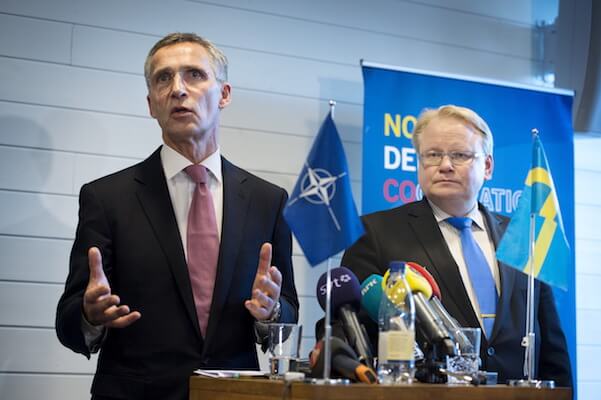By Philipp Frisch
25 October 2018
Today NATO begins its largest military exercise since the end of the Cold War. “Trident Juncture”, which is taking place in Norway and is to last almost a month, heightens the danger of a wide-ranging war between NATO and Russia. Conflicts between the major powers, which are worsening week by week, will be further exacerbated by the NATO exercise.
“Trident Juncture” brings together the armed forces of 29 NATO countries plus Sweden and Finland for massive war games. A total of 50,000 soldiers will train in winter conditions. Ten thousand vehicles and over 130 aircraft were brought to Norway last month for the manoeuvres.
Seventy ships will be involved in the naval exercise “Northern Coasts” in the North Atlantic and North Sea. The number of soldiers and amount of military equipment involved exceeds NATO’s original plans.
The major manoeuvres in northern Europe are clearly directed against Russia. According to the official explanation, the exercise is designed to train for a scenario in which NATO’s “mutual defence” clause is invoked. This means nothing else than a NATO war against Russia.
In 2014, Russia responded to the far-right coup in Ukraine, which, with massive support from the US and the EU, brought to power an anti-Russian regime in Kiev, with the annexation of Crimea. Since then, NATO has accused Russia of aggressive and expansionist policies—a construct to justify the deployment of NATO troops to the Russian border and for war games like “Trident Juncture”—and is increasingly preparing for a “mutual defence” scenario.
NATO Secretary General Jens Stoltenberg made little effort to hide the obvious. The exercise was “fictional, but realistic,” Stoltenberg said in the run-up to the meeting of NATO defence ministers earlier this month. The military alliance had invited Russia to send observers. In charge of the manoeuvres, US Admiral James Foggo said the exercise was not directed against a particular country, rather, it served to demonstrate NATO’s military capabilities “against any opponent.”
NATO diplomats, however, openly admitted that the location of the manoeuvres was not accidental. “Of course, it’s because of Russia,” said foreign policy spokesman for the social democrats in the European Parliament, Knut Fleckenstein. “The soldiers are not practicing for an attack on Guatemala, but someone coming from above—and that’s where Russia is.”
The Land Forces exercises take place only about 500 kilometres from the Russian border. Fighter aircraft will also operate in Finnish airspace, which is directly adjacent to Russian airspace. The same applies to the Baltic Sea, where parts of the naval warfare exercises will take place. These areas are regularly overflown by Russian military aircraft.
One need only imagine a major manoeuvre by Russian and Chinese armed forces, with tens of thousands of soldiers and over 100 aircraft, taking place in Mexico or Canada along with several dozen warships practicing for a major war in the Gulf of Mexico or on the East Coast of the United States, to have an idea of how provocative “Trident Juncture” is.
Maria Sakharova, the spokeswoman for the Russian Foreign Ministry, condemned the manoeuvres, describing them as “sabre-rattling”. Sakharova said, “The leading NATO countries are strengthening their military presence in the region near the Russian border,” adding that Moscow will “take the necessary countermeasures to ensure its security.”
The manoeuvres take place under conditions of explosive tensions between the major powers. At a campaign meeting in Nevada last Saturday, President Trump announced his plans for a US withdrawal from the Intermediate Range Nuclear Forces (INF) treaty. Since it was signed in 1987, the INF treaty has been one of the mainstays of international nuclear weapons control. Should Washington terminate the treaty, a new nuclear arms race between the major powers will be unleashed 30 years after the end of the Cold War.
At the end of last year, the US published its National Defense Strategy, which no longer places the “war on terror” at the heart of US military strategy, but rather, “major power competition.” The document names Russia and China as “revisionist” states and prime targets.
Such military confrontations between major powers are now being rehearsed as part of “Trident Juncture”. While the land forces in Norway are simulating a winter war, the ships in the North Atlantic are training for how supply lines can be organised in an emergency and how sea routes from the American continent to the European continent can be protected.
Preparations for the exercise, which have been staged intensively since last month, also constitute a logistical show of strength. Organising supplies for 50,000 troops and the transport of vehicles across Europe is a test of how the continent’s infrastructure is suited for the efficient deployment of large military units in a major war.
Ten thousand Bundeswehr (Armed Forces) soldiers are participating in the exercise, a new record. This means that 20 percent of those participating come from Germany. As host, only Norway is providing more troops. After two world wars, in which some 80 million people were killed, German imperialism is again preparing for criminal wars.
The Bundeswehr is supplying 4,000 vehicles, more than half the total, including about 100 tanks. The Luftwaffe (Air Force) is involved with 500 soldiers, its own air defence units, two airborne combat units and transport machines.
The strong involvement of the Bundeswehr is officially justified by the fact that it will take command of NATO’s rapid reaction force in Eastern Europe in 2019. Germany also wanted to show that it was ready to assume more responsibility within the military alliance in the future, it was reported.
In truth, it concerns much more. With the new “Bundeswehr Concept,” which was published by the government at the end of July this year, Germany is preparing once again for massive military operations.
The document states: “Conventional attacks against the Alliance are to be expected, especially on its external borders. The army must be given the capacities to operate in this area. It must have the forces and means at its disposal to deploy after a brief mobilisation to the borders or beyond alliance territory. This must include strategic deployment capabilities. … Collective defence within alliance territory can range from small-scale operations to an extremely demanding deployment within the framework of a very large operation both within and on the outskirts of alliance territory.”
It also states: “Rapid strike and follow-up capabilities for a very large operation have to be planned. They must be effectual in a hybrid conflict as it develops and escalates across the full spectrum of is effects, in all its dimensions, in a joint, multi-national armed force, and in all types of operations. At the beginning of a very large, high-intensity operation, a huge deployment of readily available forces and equipment is necessary. Provisions to regenerate the personnel and material will be undertaken.”
The NATO manoeuvres in Norway are preparing for such a “very large, high-intensity operation.” A spokesman for the German Defence Ministry said that the Bundeswehr was “deliberately taking on a pioneering role.” As part of “Trident Juncture”, the Bundeswehr was practicing for the leadership of multinational combat units. “This is a demanding task, especially when troops from many nations are to cooperate on a larger scale,” the spokesman continued.
Meanwhile, the German government has also acknowledged that the operation is not only very large, but also very expensive. The supply and relocation of troops to Norway alone is costing €90 million.











